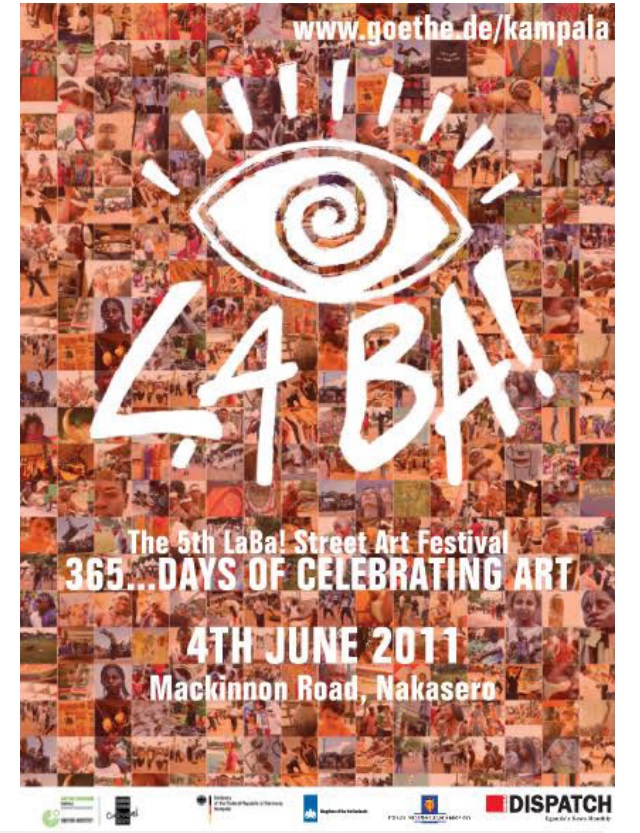
Laba! Street Art festival was an idea conceived by a group of artists to link the public to art. At the art studios and galleries, few locals were coming to interact and buy art hence, the alternative to this void was to extend art to them by way of creating an art festival that was open to everyone.
Kampala, Uganda | DOMINIC MUWANGUZI | The most outstanding facet of Laba! was to create an environment of active participation in form of interactive projects. Therefore, the first edition of the festival dubbed ‘Pot in the Hole’ saw artists and visitors to the festival fill potholes riddled along Bukoto street, Kamwokya with concrete and create pots out of this creative process. The satirical act was a gesture to raise attention to the bad condition of the road that required urgent fixing. In its subsequent editions, the festival sought to create such critical exchanges between the public and the city council (KCCA). This made it a permanent fixture on the social circuit of many Kampalans regardless of social class, gender and age.
As much as the festival was successful in drawing the local people from the streets to art-the majority of the audience was ordinary people and not the white expatriate community- there was debate on the type of art created on this platform. Indeed, some of the celebrated artists started to shun the festival arguing that it had been turned into a craft market where art could be shown and sold cheaply. Noteworthy, the quality of art on display and how it was presented raised eyebrows. Many artists, primarily driven to make quick money from this one day art bazaar, hurriedly put paint on canvas and shoved it in the face of the visitors. It did not often help if the artists had followed the theme of the festival or not. The agenda was to reap where they had invested with no consideration on creativity and innovation. A walk through the stalls attested to the replication of ideas on canvas from one artist to the next.
If Laba! lacked on class and taste; presumably one of the tenets to sell art; it is the Fireworks Annual Art Exhibition that instead possessed it. The Fireworks Annual Art Exhibition was a brainchild of the suave Fireworks Advertising Agency located in the leafy neighbourhood of Kololo Hill. The strategy for this exhibit was to have some of the best artists in the industry create art and its exhibited in the office space of the agency. The company would then send out invites to its clienteles; particularly Corporate Executives. These were hosted to expensive whiskeys, wines and finger foods as they appreciated art on sale. Art worth millions of shillings was often sold on the first night and more purchases were made in the subsequent days that followed the opening evening. This was undoubtedly the ideal way to sell art: in a hustle free environment with paintings carefully displayed against whitewashed walls and CEO talking in US dollars. But the irony for this enterprise was that these were the exact same people who were quietly buying art from the galleries and art studios in Kampala. Art needed to find new audiences to break its norm of exclusivity among the public.
It is difficult to sell art anywhere-including the first world- and not think of a specific type of people. This has been the dilemma for artists in Uganda who want to reach more people with their art but in the end only a small fraction can access it and maybe afford it. Henry Mzili, a seasoned eclectic artist grappled with this reality. He originally produced art reflecting the personality of his surroundings with intent to break through main stream society but it’s only the affluent white audience that could relate to it. His use of tactile objects like barkcloth, cowrie shells and beads that are part of Buganda material culture was an attempt to realize this objective of localizing his art. Similarly, Fred Mutebi extensive use of barkcloth in his art is a metaphor for inciting dialogue on social issues in his surroundings. Again, the biggest clientele of Mutebi’s wood cut prints are white expatriate community. These buy the art because of its social resonance; an avenue through which the outsider can learn about the indigenous people.
It is obvious that there is little artists can do to resolve this disparity in art consumption locally. Even with the interventions of Laba! and Fireworks Advertising and most recently Kampala Art Festival (KLA ART) the Ugandan audience mostly still remains evasive to art. It has been blamed to several factors including the stereotype attached to art that it’s only affordable and consumable by those who earn in dollars: the white expatriate community. This has been ironically emphasized by the pricing of art in dollars in Uganda! But while this can make sense, one should not forget the lay man’s understanding of art influenced by the colonial masters. From the theoretical books of the British colonialists, art was always considered as a hobby and not a serious profession like Engineering, Medicine or Law. We all can relate to this fact from high school when art was presented to us as an optional subject in the curriculum -still developed by the colonial masters. To this end, artists need to start doing things differently to get the deserving recognition they quest for. This can be a trigger to have art reach more of the Ugandan audience.
****
 The Independent Uganda: You get the Truth we Pay the Price
The Independent Uganda: You get the Truth we Pay the Price


